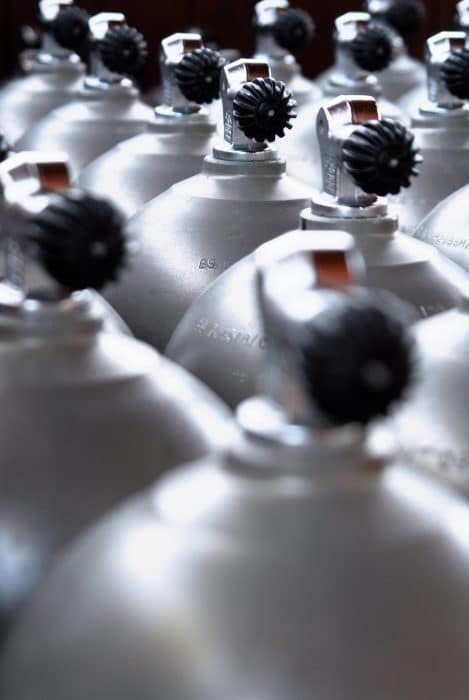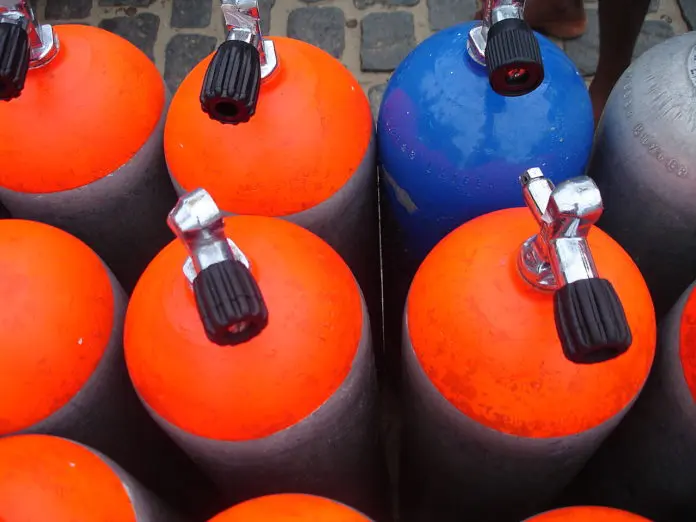Whether you call them dive tanks or scuba cylinders or a variation of those terms, the container that holds your air while you dive is a critical part of your equipment. It is also the least understood, most abused and possibly the least used if you purchase one.
Do you need to own a scuba cylinder?
Many new divers will get their full dive kit and feel it is not complete without their own dive cylinders. Most will start off with two. The most common dive outing is the two tank dive. After they buy them, the tanks just sit there gathering dust. There are reasons which make getting your own cylinders a waste of money, there are also great reasons to get your own. Here are a few things to consider if you are thinking of getting your own:
- Saving money is not a valid reason for buying your own scuba cylinders. The most common model of dive cylinder cost around $180. The cost of a fill and the cost of renting a tank may only be a dollar different if any at all. Most dive packages include the tanks as a part of the package.
- Air travel is difficult. There are strict rules for taking a scuba cylinder on an airplane. One key point is that it must be empty and the valve removed. Then there is the additional airfare cost. An empty tank can still weight more than 30 pounds and you will likely take two if you take any. Most airlines will require you to pay extra for sports equipment. The trend is that airlines also charge you by leg. So if you change planes along the way, each flight is an additional cost. It is possible to damage a valve if improperly removed. It is recommended that valves only be replaced by a qualified technician after a visible inspection has been done. Valves are torqued to specifications. If you fly to most of your dive destinations, you will likely leave the tanks at home.
- Required Inspections. As mentioned, a scuba cylinder has to be inspected anytime the valve is to be connected to the tank. This visual inspection is also an annual requirement. Fill stations cannot legally fill a scuba tank that has an expired visual inspection. Additionally, a scuba tank needs a hydrostatic (hydro) test periodically. In this test, the tank is over pressurized and the amount of expansion of the tank is measured. If the expansion is beyond the standards, the tank is condemned and destroyed. In the United States, a hydro test is required every five years. Other countries have their own laws as an example, Australia required an annual hydro.
- You need to get your tanks filled. The timing of this will be influenced by the storage requirement. If you are renting tanks, it is likely that the dive center has them readily available. If you just drop in to have your tanks filled, the dive center might be able to do them right away.
- Do you need a special size cylinder? I had one dive buddy who was on the petite side. For her, an Al 80 was too long. An AL63 was the best for her. Her local dive center did not have that size, so she bought her own

Storing your scuba cylinders
Now that you have convinced yourself that you really do need your own scuba cylinders, you need to find a place to store them. No problem, you can always make room on a shelve in the garage. Oops, wrong answer, for a few reasons. We are taught to lay a tank on its side while we are waiting to dive. However, This is not the way to store a tank. Tanks should be stored upright and secured so they will not fall over. While we may complain about how dry the air is that we breathe underwater, there is still some moisture. That moisture will lead to some corrosion. Dive tanks are thicker on the bottom which results in less impact if there is corrosion compared to laying on the side and corroding the thinner wall.
In the summer, many garages can get very hot. Hot enough for the internal pressure to increase and activating the burst disk. So look for a storage place that is cooler and has air circulation. Speaking of internal pressures brings us to the point of do you store your tanks empty or full. If it is just short-term storage, up to 90 days, then you can store them full it you wish.
However, for a long-term storage, it is recommended that you store them almost empty. There are many viewpoints on what is “almost” empty. You do not want the pressure inside the cylinder to be equal to or less than the pressure outside of the tank. This can help lead to the valve seals failing and outside contamination to enter. This could be dust or moisture. You will often hear that you should leave 200 psi/15 bar remaining in your tank. While much better than a tank at 3,000 psi/ 200 bar, a pressure this high could still help speed up corrosion with the higher oxygen partial pressure. A pressure of 50 psi or 3 bar is much better. If your pressure gauge is not that accurate, bring it down to the lowest measurable pressure. When you do bring the pressure down, do so slowly. Allowing the air to rapidly leave the tank will heat up the tank. When it cools, condensation will form on the inside of the tank.
Clean the outside of your tank with fresh water and wipe it dry before storing. The same with the valve. If you have a cover or a boot on your tank, take them off and clean them as well as cleaning the items themselves.
Transporting your dive tanks
Check for any restrictions before transporting your filled scuba tanks. Transporting compressed gases does have restrictions. Generally, a scuba tank is excepted from the restrictions but it is best to verify that yourself.
Even before you move your tanks, remember the proper way to grab a tank. When you lift a tank, have the valve opening facing away from your hand. If the valve is facing your hand and you accidentally open the valve, the air will be forced into your skin along with anything that might have been on the valve or your skin. Remember the flu shot you got with a jet injector? Same principle.
When transporting your scuba tank it should be on its side and blocked in such a way that it cannot move, even with an emergency stop. That sudden stop can propel your tank with a deadly impact. If possible, the area where the tanks are being transported should have air circulation. If that is not possible, on hot days stop every so often and allow the hot air to escape.
Having your own tanks can be a benefit, but not everyone needs their own.

